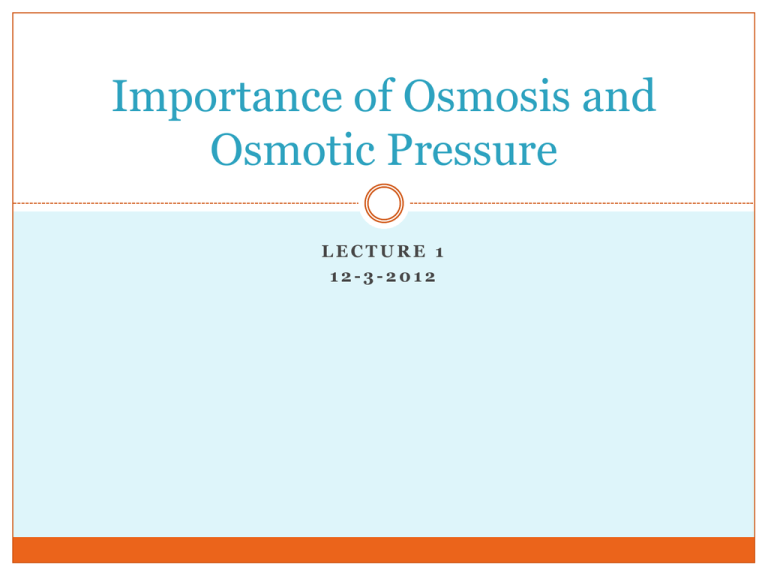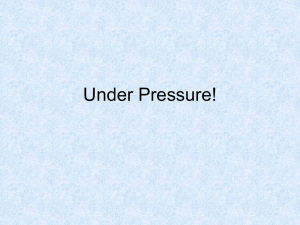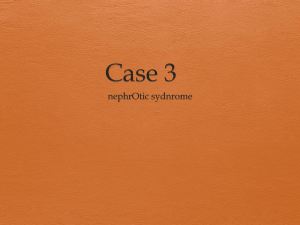lecture 1 12-3-2012
advertisement

Importance of Osmosis and Osmotic Pressure LECTURE 1 12-3-2012 Osmotic pressure The pressure of a solution which just stops osmosis is the osmotic pressure Osmotic pressure is the excess of the pressure required to equalize water activities in the two compartments The term osmotic pressure is used for a solution and not for a solvent All non penetrable solutes in a solution exerts oncotic pressure Factors on which osmotic pressure depends Van’t Hoffs Equation According to Van’t Hoff, osmotic pressure (π) depends on the molar concentration (C) of the solution and the temperature T Where and R is the gas constant The osmotic pressure doesn’t depend on the nature of the dissolved substance; it depends only on the concentration, temperature and molecule weight. Osmotic pressure is higher when concentration difference is higher or temperature is higher and the molecular weight is lower Osmolarity/Osmolality Osmotic pressure depends mainly on the molar concentration or molarity of a solution To describe the total number of osmotically active particles per litre of solution term osmolarity is used Molecules like glucose do not dissociate in water, and only contribute one particle per molecule. NaCl does dissociate in water (into Na+ and Cl-), so there are two particles per molecule in solution. OsM of 1 M glucose =1 OsM OsM of 1 M NaCl = 2 OsM So, two solutions can have the same molarity but different osmolarities. The higher the osmolarity, the greater the osmotic pressure of the solution. The osmotic pressure of an ionic solution is where I is the numberof ions formed by dissociation per molecule Importance of Osmosis and Osmotic Pressure Oncotic pressure of blood plasma Formation of tissue fluid Regulation of cell volume Oncotic pressure of blood plasma Some 90% by weight of plasma is water and about 8% is plasma proteins (albumin, globulins, fibrinogens) Blood plasma is an aqueous solution containing different ions (Na+, K+, Ca2+…), small non dissociated molecules (glucose, amino acids) and proteins- macromolecules (albumin, globulin etc). Each type of molecules contributes with its own osmotic pressure, the sum representing the colloid-osmotic pressure or oncotic pressure of plasma πplasma = ∑ πmol + ∑ πions+ ∑ πproteins Oncotic pressure of plasma usually tends to pull water into the circulatory system Albumin is the major contributor to oncotic pressure of plasma because it has the lowest molecular weight of the major plasma proteins and its concentration is almost double that of globulin In addition albumin binds with Cl- ions which causes attraction and retention of cations in the vascular compartments and repulsion of diffusible anions The total oncotic pressure of an average capillary is about 28 mmHg with albumin contributing approximately 22 mmHg of this oncotic pressure. Throughout the body, dissolved compounds have an osmotic pressure. Because large plasma proteins cannot easily cross through the capillary walls, their effect on the osmotic pressure of the capillary interiors will, to some extent, balance out the tendency for fluid to leak out of the capillaries. In other words, the oncotic pressure tends to pull fluid into the capillaries. Tissue Fluid Formation Filtration takes place at the arterial end of capillary because hydrostatic pressure of blood overcomes the oncotic pressure of plasma proteins Reabsorption takes place at the venous end of capillary because hydrostatic pressure of blood falls below the oncotic pressure of plasma proteins Net result of this filtration and reabsorption process is the tissue fluid formation. The balancing of filtration/ultrafiltration and reabsorption/osmosis at arterial and venous end of capillary is referred to as the Starling Equilibrium Removal of tissue fluid To prevent a build up of tissue fluid surrounding the cells in the tissue, the lymphatic system plays a part in the transport of tissue fluid. Tissue fluid can pass into the surrounding lymph vessels, and eventually ends up rejoining the blood Tissue Fluid Formation Tissue Fluid Formation Edema If the ultrafiltration is excessive, the volume of interstitial fluid increases. When it becomes clinically detectable, it is called edema Venous obstruction, erect posture and plasma protein deficiency can lead to edema In conditions where plasma proteins are reduced, e.g. from being lost in the urine (proteinuria) or from malnutrition, there will be a reduction in oncotic pressure and an increase in filtration across the capillary, resulting in excess fluid buildup in the tissues Fluid reabsorption into capillaries increases after haemorrhage. Such response helps to restore blood volume Excessive reabsorption also occurs during decreased venous pressure and dehydration Maintenance of Cell Volume The determinants of cell volume are the total number of osmotically active particles within the cell and the osmolarity of the extracellular fluid. The cell has a considerable quantity of impermeant solutes i. e. proteins ans organic phosphates whereas the interstitial fluid is relatively devoid of these. Hence there exists a colloid osmotic gradient across the cell and this would draw fluid into the cell. This effect of cell macromolecules if offset by the Na+-K+ pump Maintenance of Cell Volume 3 positive ions (Na+) are pumped out of the cell (towards ECF) for every 2 positive ions (K+) pumped into the cell (towards ICF). This means that there is more positive charges leaving the cell than entering it. As a result, positive charge builds up outside the cell compared to inside the cell. The difference in charge between the outside and inside of the cell limits the fluid flow into the cell About 90% of the osmotic pressre of extracellular fluid is due to sodium ions Maintenance of body fluid osmolality by Kidney Kidney maintains the optimum osmolality of body fluid by regulating the volume of body fluids When water intake is low or when water is lost through diarrhea or perspiration, the kidney conserves water by producing a small volume of urine which is hypertonic When water intake is high, the kidney excretes a large volume of hypotonic urine. Kidney maintains normal osmolality by regulating excretion of water and sodium chloride within a narrow range Reverse Osmosis Reverse osmosis is a membrane based filtration method that removes many types of large molecules and ions from solutions by applying pressure to the solution when it is on one side of a selective membrane. If an external pressure is applied on a concentrated solution, this pressure is distributed evenly throughout the solution If the applied pressure is higher than the osmotic pressure water will flow towards the other side of the membrane leaving solute behind This technique is used for purification of water Reverse Osmosis







